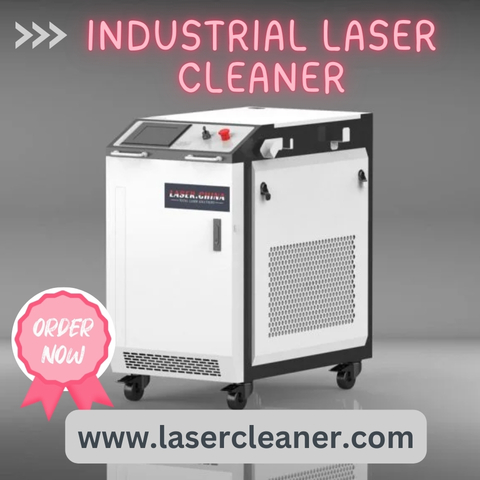In today’s fast-evolving manufacturing world, industrial cleaning is no longer just about removing dirt or rust—it’s about efficiency, safety, sustainability, and precision. One of the most talked-about innovations in this space is the industrial laser cleaner. With factories under pressure to increase productivity while complying with environmental standards, more and more companies are turning away from abrasive or chemical-based cleaning methods. But what’s causing this shift, and why now?
Let’s break it down. In this guide, we’ll explore what makes the industrial laser cleaner the go-to choice for factories, metal workshops, automotive lines, and aerospace plants. We’ll also uncover the processes behind its operation, the industries adopting it, and how it’s changing the game on production floors.
Understanding the Technology Behind an Industrial Laser Cleaner
The core of an industrial laser cleaner lies in its precision-based application of high-energy laser beams. These beams are directed at contaminants—like rust, paint, oil, or oxides—on metal or composite surfaces. When the laser light hits these materials, it causes rapid thermal expansion, breaking the bond between the contamination and the base surface without damaging the underlying material.
This process is non-contact and controlled digitally, allowing for consistent cleaning patterns. What makes it particularly unique is that it doesn’t require solvents, sandblasting, or water.
It’s not science fiction. It’s photothermal cleaning using solid-state fiber lasers, and it’s being deployed in thousands of industrial setups worldwide.
Why Industrial Sites Are Making the Switch
Factory owners and production managers are always on the hunt for methods that reduce downtime, limit health risks, and comply with strict regulatory guidelines. The industrial laser cleaner meets all of these priorities. Whether it’s removing old paint from aircraft parts or cleaning welding seams before joining, the laser cleaning process offers a level of consistency that traditional abrasive methods often fail to deliver.
In high-volume production environments like automotive or aerospace, even seconds of downtime can lead to losses. Manual cleaning methods often introduce variability and damage, leading to component rejection. With an industrial laser cleaner, the control is precise, predictable, and programmable, ensuring minimal rework.
Industrial Applications Where Laser Cleaning Is Dominating
Let’s look at how specific industries are using this technology:
Automotive Sector
In automobile manufacturing plants, components like engine blocks, brake discs, and gearbox housings require surface preparation before assembly. An industrial laser cleaner effectively removes oxides, oils, and residues, ensuring proper bonding or welding without degrading the metal surface.
Aerospace Industry
Aircraft parts, especially those made of aluminum and titanium, need to be cleaned with minimal material loss. Laser cleaning ensures the protective layers remain intact while the contaminants are removed. It’s also commonly used for mold cleaning in composite material production.
Shipbuilding and Marine
In marine maintenance, cleaning corrosion from metal parts is a constant task. Traditional methods such as sandblasting contribute to environmental pollution and require extensive protective equipment. An industrial laser cleaner offers a cleaner alternative that reduces waste and improves worker safety.
Electronics Manufacturing
PCB cleaning, stencil cleaning, and selective oxide removal are sensitive tasks where precision is critical. Laser technology allows micro-level cleaning without compromising the substrate or delicate circuitry.
Metal Fabrication
Fabrication units often use laser cleaning to remove slag, welding residues, or prepare parts for powder coating. It increases the lifespan of tools and ensures coatings adhere properly.
What Happens Inside the Laser Cleaning Process?
Here’s what happens step-by-step when you use an industrial laser cleaner:
- Target Selection
The operator identifies the contamination or coating that needs to be removed. - Laser Configuration
Based on the surface type and contamination, the appropriate laser parameters are selected—wavelength, pulse duration, and intensity. - Cleaning Pass
The laser beam is directed via a handheld or robotic head across the surface. The beam interacts with the contamination layer, vaporizing or breaking it apart thermally. - Residue Collection
Fumes or particles released are extracted through an integrated vacuum or filtered collection system, making the process clean and contained. - Inspection and Repeat
Once the pass is complete, the operator can visually inspect the area. If needed, another pass can be made without altering the material below.
This entire process takes place without using chemicals, abrasives, or mechanical tools. That’s why many manufacturers consider it a ‘dry’ cleaning method with reduced operating costs over time.
What Makes It a Preferred Investment for Industry Leaders?
Cost, precision, and speed are not the only deciding factors anymore. Factory management teams today have to think long-term. They must consider worker safety, emissions, compliance with regional laws, and the carbon footprint of their operations.
Here are some of the strategic reasons why companies adopt an industrial laser cleaner:
- To comply with local environmental standards by avoiding solvents and abrasives.
- To improve worker safety by eliminating exposure to hazardous chemicals.
- To reduce operational costs by minimizing waste disposal and maintenance.
- To increase automation compatibility with robotic integration.
- To ensure repeatability and control in cleaning outcomes across shifts or production batches.
The ability to integrate these machines into fully automated assembly lines using robotic arms or gantry systems makes them even more attractive to Industry 4.0 adopters.
Common Contaminants an Industrial Laser Cleaner Can Handle
It’s important to clarify what materials and contaminants can be treated effectively. An industrial laser cleaner isn’t limited to one use case—it’s versatile.
It can clean:
- Rust and corrosion layers
- Paint and graffiti
- Grease and oil films
- Carbon deposits
- Oxide layers after welding
- Residue from coatings or adhesives
- Mold release agents from tooling
- Tarnish and patina on metals
Whether the application is heavy-duty or micro-precise, different models and configurations are available for each use case.
What to Know Before Choosing One
Though we’re not covering features or benefits directly, understanding the nature of laser cleaning systems helps in making the right investment. Industrial laser cleaner systems vary based on laser power, mobility (handheld vs. robotic), and automation level.
Low-power models might be suitable for fine applications like heritage restoration or electronics. In contrast, high-power laser cleaners (1000W or more) are used for heavy rust removal, coating stripping, or oxide cleaning in metal fabrication.
It’s essential to match the cleaner to the task. Consulting with experienced manufacturers and evaluating your material throughput, surface type, and budget will help determine the right system.
Final Thoughts
The industrial landscape is shifting toward cleaner, smarter, and more efficient operations. As environmental laws tighten and production demands rise, outdated cleaning methods like chemical dips and sandblasting are losing favor. The industrial laser cleaner is not just a tool—it’s a symbol of where manufacturing is headed. Precision, safety, and sustainability are no longer optional. They’re expected.
Factories that adopt laser cleaning today are positioning themselves ahead of the curve. They reduce their waste, protect their workers, and gain a competitive edge in quality control. The question isn’t whether industrial laser cleaning works—it’s how fast your facility can adapt to it.





